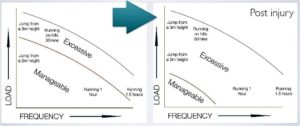The human body is an amazingly adaptable and responsive piece of machinery, made up of complex living tissue. The tissue in our bodies is exposed to a wide range of loads depending on the tasks that we undertake as well as the movement patterns and degree of muscular control that we undertake these movements with.
Structural tissue in the body is in a constant state of flux in response to the forces and loads that is undergoes. If we place more load on a piece of tissue that it can absorb, failures of the tissue occur and this stimulates the body to build a stronger more robust piece of tissue. Conversely if you regularly underload tissue and these micro-failures of the tissue do not occur, the body will allow the tissue to become weaker. The age-old adage “use it or lose it” could not be more true.
Loading tissue during sport and exercise is a healthy thing to do and in fact is essential in promoting adaptions such as improved strength and load capacity of our tissues. The rate at which this load takes place however is quite important. While the body will respond positively to any overload to the tissue, if we push too far or too quickly, the body is not able to adapt quickly enough and we get a painful reactive response and tissue damage. In this environment, the injured tissues ability to withstand load starts to significantly be reduced as shown below.
 One of the most common causes of injury onset is increasing training load to the tissues too quickly. This can be a result of increasing training volume, frequency or intensity at a rate faster than the body is able to adapt to. It is important to recognise that training load is not the only consideration when looking at overload to tissue. Biomechanics plays a vital part in determining the amount of undue load placed on tissues, with poor biomechanics placing increased detrimental load on tissues, resulting in increased tissue damage and injury risk. As such improving strength and control of the whole kinetic chain is much more beneficial than simply focusing on increasing load capacity of a particular piece of tissue.
One of the most common causes of injury onset is increasing training load to the tissues too quickly. This can be a result of increasing training volume, frequency or intensity at a rate faster than the body is able to adapt to. It is important to recognise that training load is not the only consideration when looking at overload to tissue. Biomechanics plays a vital part in determining the amount of undue load placed on tissues, with poor biomechanics placing increased detrimental load on tissues, resulting in increased tissue damage and injury risk. As such improving strength and control of the whole kinetic chain is much more beneficial than simply focusing on increasing load capacity of a particular piece of tissue.
Nutrition is now widely recognised as playing a vital part in the body’s ability to repair and strengthen tissue. It makes sense that if you do not fuel your body with a diet full of quality protein and plenty of vitamins and minerals from fresh fruit and vegetables then the systems that are charged with repairing and maintaining your tissue will be depleted and not function to their potential.
To avoid pain and injury, ensure that you increase your training load in a slow and linear manner, make sure that you try to incorporate some strength training to improve overall biomechanics and ensure that you fuel your body with a healthy nutritious diet.
Article by Jim Burke
